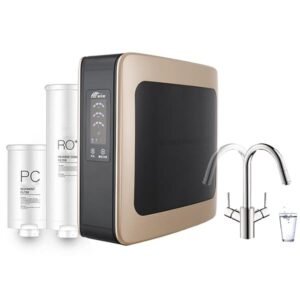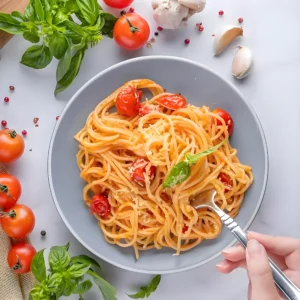Water filters are devices designed to remove impurities, pollutants, and unpleasant odors from water. With the increasing scarcity and pollution of water resources, the widespread use of water filters has become an indispensable part of people’s lives.
The principle behind water filters lies in their filtration cartridges. These cartridges, made of various materials such as ceramics, activated carbon, and polyester fibers, work to capture, adsorb, or chemically react with impurities in the water as it passes through. This process effectively purifies the water, ensuring its safety and quality for consumption and other purposes.
In the current market, there is a wide variety of water filters available, including water purifiers, kitchen filters, water dispensers, and shower filters.
- Water purifiers are primarily used in homes, offices, and other small-scale settings to eliminate impurities, odors, heavy metals, and other harmful substances from drinking water, thereby enhancing its safety and taste.
- Kitchen filters improve the quality of water used in cooking by reducing scale buildup and impurities, resulting in healthier and more delicious meals.
- Water dispensers combine multiple filtration functions with the convenience of hot and cold water dispensing, making them suitable for various settings such as homes, offices, and schools.
- Shower filters aim to reduce harmful dissolved chlorine and other substances in water that can adversely affect the skin, resulting in softer and smoother skin.
In summary, water filters are essential devices that address issues related to water pollution and deteriorating water quality, helping to improve the quality of our daily lives and safeguarding our health.
The core of its technology is the filtration membrane in the filter element device. The main technologies come from three types: ultrafiltration membrane, RO reverse osmosis membrane, and nanofiltration membrane.
Product Description
Water purifiers can be classified into two main types based on their pipeline design: gradual tightening water purifiers and self-cleaning water purifiers. Traditional water purifiers belong to the gradual tightening category. Their internal pipeline design involves loosening before the filter and tightening afterward. Typically, they consist of five stages connected end-to-end: PP melt-blown filter, granular carbon, compressed carbon, RO reverse osmosis membrane or ultrafiltration membrane, and post-activated carbon. Deposits accumulate inside the filter, necessitating regular manual cleaning to ensure proper machine operation. The more advanced self-cleaning water purifier features two internal channels. An additional washing water channel is added for everyday use. As the washing water passes through the filter, especially the membrane filter, on the raw water side, it acts as a flush to achieve self-cleaning. Utilizing the moment of opening and closing the washing water tap, water that is normally discharged from both ends is used to timely and quickly discharge trapped dirt. This design structure is reasonable, eliminating the hassle of manual cleaning, preventing re-pollution of the mechanism itself, and reducing energy costs.
Consumers should pay attention to distinguishing between self-cleaning water purifiers and other types commonly seen on the market, such as automatic drainage water purifiers, computer-controlled automatic flushing water purifiers, and automatic backwashing water purifiers. The former cleans the entire machine, meaning all filters inside the machine have a certain self-cleaning function, while the latter only washes one filter rather than the entire machine. In simple terms, a self-cleaning water purifier is like installing a garbage disposal unit on the pipeline, with dirt being cleaned out at any time and not lingering inside the machine. In contrast, traditional non-self-cleaning water purifiers are like having multiple trash cans in a room, with dirt temporarily stored inside the machine, requiring regular drainage, cleaning, and frequent replacement of filters.

Household Water Purification
The function of a water purifier is to remove suspended solids, heavy metals, bacteria, viruses, chlorine residual, sediment, rust, microorganisms, and other impurities from water. It employs high-precision filtration technology. In household water purifiers, the five-stage filtration technology typically includes a PP cotton filter (PPF) as the first stage, followed by a granular activated carbon (UDF) filter as the second stage, a precision compressed activated carbon (CTO) filter as the third stage, a reverse osmosis membrane or ultrafiltration membrane as the fourth stage, and a post-activated carbon filter (small T33) as the fifth stage. Water purifiers are not only suitable for areas with severe contamination of tap water but also capable of filtering out residual chlorine in regular tap water, thus improving the taste of the water.
Working Principle
First Stage: PP Cotton Filter – Removes visible particles/dust and impurities from tap water. Second and Third Stages: Pre-activated Carbon – In some lower-end water purifiers, the third stage may also be PP cotton. The carbon removes chlorine and organic impurities, as well as absorbs odors, colors, and tastes produced by organic compounds. Fourth Stage: Ultrafiltration or Reverse Osmosis Membrane – The membrane removes bacteria, viruses, and spores from the water. Fifth Stage: Post-Activated Carbon Unit – Further improves taste and removes odors. Most water purifiers adopt a progressive structure based on the principle of barrier filtration. They consist of multiple filter stages connected end-to-end, with filters arranged in increasing precision to distribute trapped pollutants across multiple stages, thereby reducing clogging and the frequency of manual cleaning, drainage, and filter replacement. Another design approach is the application of self-cleaning structures based on the principle of quality separation flow. Instead of providing as much space as possible to trap pollutants, this design separates a small portion of clean water and allows the rest of the water to flow normally, carrying away pollutants with the flow, achieving non-stagnant water flow. This method purifies water without allowing pollutants to accumulate in the machine, avoiding secondary pollution and significantly reducing filter wear and tear, resulting in better, safer, energy-efficient, and low-carbon water quality. This new principle of self-cleaning water purifiers won the gold award at the 7th International Invention Exhibition. It features a one-in, two-out structure, improving upon the traditional water purifier’s shortcomings where pollutants tend to accumulate inside the machine due to its one-in, one-out structure, eventually turning into wastewater. Therefore, the concept of wastewater and drainage in traditional water purifiers is replaced by washing water in self-cleaning water purifiers. With the improvement of living standards, the popularity of water purifiers will continue to grow, and new technological products are better meeting people’s needs.


